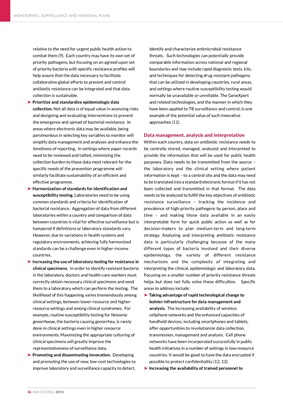
relative to the need for urgent public health action to
combat them (9). Each country may have its own set of
priority pathogens, but focusing on an agreed-upon set
of priority bacteria with specific resistance profiles will
help assure that the data necessary to facilitate
collaborative global efforts to prevent and control
antibiotic resistance can be integrated and that data
collection is sustainable.
‰ Prioritize and standardize epidemiologic data
collection. Not all data is of equal value in assessing risks
and designing and evaluating interventions to prevent
the emergence and spread of bacterial resistance. In
areas where electronic data may be available, being
parsimonious in selecting key variables to monitor will
simplify data management and analyses and enhance the
timeliness of reporting. In settings where paper records
need to be reviewed and tallied, minimizing the
collection burden to those data most relevant for the
specific needs of the prevention programme will
similarly facilitate sustainability of an efficient and
effective programme.
‰ Harmonization of standards for identification and
susceptibility testing. Laboratories need to be using
common standards and criteria for identification of
bacterial resistance. Aggregation of data from different
laboratories within a country and comparison of data
between countries is vital for effective surveillance but is
hampered if definitions or laboratory standards vary.
However, due to variations in health systems and
regulatory environments, achieving fully harmonized
standards can be a challenge even in higher-income
countries.
‰ Increasing the use of laboratory testing for resistance in
clinical specimens. In order to identify resistant bacteria
in the laboratory, doctors and health-care workers must
correctly obtain necessary clinical specimens and send
them to a laboratory which can perform the testing. The
likelihood of this happening varies tremendously among
clinical settings, between lower-resource and higherresource
settings and among clinical syndromes. For
example, routine susceptibility testing for Neisseria
gonorrhoeae, the bacteria causing gonorrhea, is rarely
done in clinical settings even in higher resource
environments. Maximizing the appropriate culturing of
clinical specimens will greatly improve the
representativeness of surveillance data.
‰ Promoting and disseminating innovation. Developing
and promoting the use of new, low-cost technologies to
improve laboratory and surveillance capacity to detect,
identify and characterize antimicrobial resistance
threats. Such technologies can potentially provide
comparable information across national and regional
boundaries and may include rapid diagnostic tests, kits,
and techniques for detecting drug resistant pathogens
that can be utilized in developing countries, rural areas,
and settings where routine susceptibility testing would
normally be unavailable or unreliable. The GeneXpert
and related technologies, and the manner in which they
have been applied to TB surveillance and control, is one
example of the potential value of such innovative
approaches (11).
Data management, analysis and interpretation
Within each country, data on antibiotic resistance needs to
be centrally stored, managed, analyzed and interpreted to
provide the information that will be used for public health
purposes. Data needs to be transmitted from the source -
the laboratory and the clinical setting where patient
information is kept - to a central site and the data may need
to be translated into a standard electronic format if it has not
been collected and transmitted in that format. The data
needs to be analyzed to fulfill the key objectives of antibiotic
resistance surveillance - tracking the incidence and
prevalence of high-priority pathogens by person, place and
time - and making those data available in an easily
interpretable form for quick public action as well as for
decision-makers to plan medium-term and long-term
strategy. Analyzing and interpreting antibiotic resistance
data is particularly challenging because of the many
different types of bacteria involved and their diverse
epidemiology, the variety of different resistance
mechanisms and the complexity of integrating and
interpreting the clinical, epidemiologic and laboratory data.
Focusing on a smaller number of priority resistance threats
helps but does not fully solve these difficulties. Specific
areas to address include:
‰ Taking advantage of rapid technological change to
bolster infrastructure for data management and
analysis. The increasing availability of wireless
cellphone networks and the enhanced capacities of
handheld devices, including smartphones and tablets,
offer opportunities to revolutionize data collection,
transmission, management and analysis. Cell phone
networks have been incorporated successfully in public
health initiatives in a number of settings in low-resource
countries. It would be good to have the data encrypted if
possible to protect confidentiality (12, 13).
‰ Increasing the availability of trained personnel to
MONITORING, SURVEILLANCE AND NATIONAL PLANS
36 AMR CONTROL 2015